 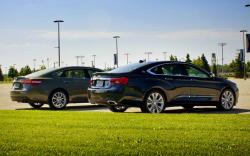 2014 Chevrolet Impala vs 2013 Toyota Avalon. Click image to enlarge |
Review and photos by Jeff Wilson
If the marketing folks are to be believed, what a person owns can speak volumes about who they are. Compact SUV drivers are all active, adventurous outdoorsy types. If you drive a gleaming, silver German sport sedan you are surely a successful business tycoon, right?
Sometimes society bestows its own stereotypes – for better or for worse – on specific automotive choices. A minivan means a frazzled soccer mom with a busload of hyperactive kids. That expensive red sports car has to be owned by some guy going through a mid-life crisis. And of course large, comfortable sedans are only driven (much too slowly, no doubt) by senior citizens or by unwitting rental car victims.
Millions are spent to try to reverse these negative brand associations and expand sales to make us believe sports cars are driven only by true automotive connoisseurs, or that even a minivan can be fun (remember that Toyota Sienna commercial with the power-sliding minivan?). But the reality is that changing the public’s automotive perception is a slow and difficult process.
One of General Motors’ most storied nameplates – the Chevrolet Impala – has had a roller-coaster ride of reputation over the years. From highly desirable ‘60s SS models (which enjoyed a resurgence of popularity as the customized choice of the hip-hop set) to the sad – if reliable – darling of rental car fleets and grandpas across America, the mighty Impala’s luster has worn off.
In the mid 1990s, Toyota introduced a large sedan based on a stretched Camry platform that offered all the driving zeal and styling of soggy Melba toast. It became a popular choice only amongst those seeking the anti-enthusiast features of a bench seat and column shifter in a car with the brand’s storied durability. Sensible? Sure. Stylish? Not quite. Fun? Umm… not a bit.
  Test drivers Edward and David. Click image to enlarge |
The Impala and Avalon have catered to largely the same market of drivers who seek a machine whose ride is supple and whose dimensions are akin to those of the land yachts they learned to drive several decades ago.
The reality of selling to that demographic is the unfortunate and inevitable shrinking of the market. But 65 is the new 45, those active and affluent Baby Boomers with good health and long retirements have many good driving years ahead, and cars targeting this group must have a more youthful spin.
In response to this, both Chevy and Toyota have recently introduced new versions of familiar nameplates that should not only appeal to these younger-at-heart folks, but maybe even scoop up some actual younger buyers along the way.
With that, Editor Jacob Black and I gathered our two stately sedans and headed west of Toronto to the Stonecroft Adult Lifestyle Community to get the expert opinions of David and Edward, two gentlemen representing the 65+ crowd that fall directly into the prime target market for each of these cars. They’re retired, educated professionals with a lot of good living to do and have the means to pay for quality without the foolishness of spending frivolously just to have a fancy badge on their cars.
Along the way, Jacob and I fashioned our own opinions.
Exterior Styling
Let’s just be clear straight off: these have each become very handsome cars. We need look back only to the outgoing model of either of these vehicles to see just how much effort each manufacturer put into styling these machines. No longer the automotive fashion equivalent of pleated khakis with a brass-buttoned blazer (or perhaps a favourite sweater), these two in their upper trim levels, more a finely tailored and contemporary suit.
The Impala sports the family features of the restyled 2014 Camaro’s butch-looking nose and tail. The profile of the car is solid, but classy, and especially when finished in the rich dark blue metallic of our tester, the Impala looks really smart.
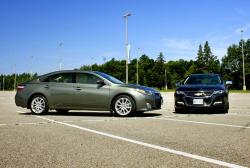 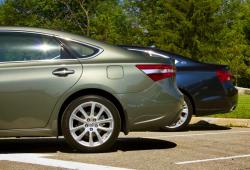 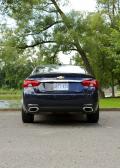 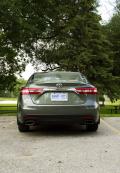 2014 Chevrolet Impala vs 2013 Toyota Avalon. Click image to enlarge |
Toyota’s Avalon is an even greater departure from its blandmobile namesake of yore. The new Avalon has a more aggressive face than its predecessor and is downright sleek by comparison. Compared to the beefy-looking Chevrolet, the Avalon appears lighter and more delicate. Despite the dramatic update, Edward declared the Avalon to appear already “dated” next to the Impala, though we all agreed it is still an attractive sedan.
Still, with its chiseled yet sophisticated stance, 20-inch wheels and well-sorted tailoring from every angle, the Impala is the unanimous victor in the looks department.
Interior
Inside the cars could not be more different. Both are cavernous – and although the rear seat (and trunk) of the Impala feel limo-like, the numbers surprisingly show the Avalon actually offers greater front and rear legroom, rear headroom, and hip and shoulder room with 3,027 L of passenger volume versus the Impala’s still-huge 2,973 L.
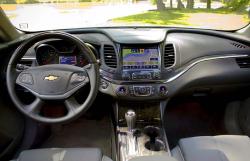 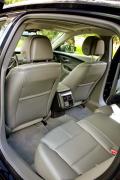  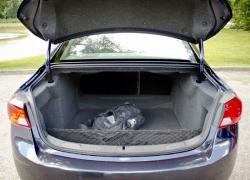 2014 Chevrolet Impala. Click image to enlarge |
It’s the styling and materials that really set these two apart though. At first glance the Impala looks fairly fetching with its leather seats and soft-touch materials throughout. Closer inspection reveals some strange and alarming discoveries. Contrasting stitching from the seat leather is a common contemporary touch, but when two adjacent surfaces feature different colours of stitching as seen in the Impala’s armrest versus seat, it simply looks like cost cutting or carelessness on the designer’s part.
Panel fitment in the Impala’s interior was a bit of a concern on our test car. The dashboard aligns a centimeter or two higher where it meets the driver’s door, but the same measure lower where it meets the passenger door.
The Toyota on the other hand features extreme tolerances and precise fitments, plus it’s beautifully finished. Soft, rich leathers feel several grades more expensive than the hard hides in the Impala. While Jacob found the juxtaposing beige, chocolate and black surfaces very off-putting, the rest of our group quite liked the look of the Avalon’s inner contrasts.
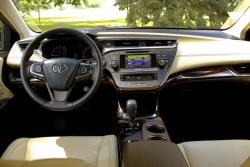 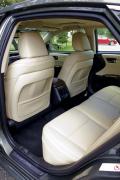 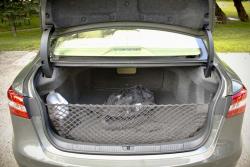 2013 Toyota Avalon. Click image to enlarge |
Despite its styling miscue, the Impala’s seat was deemed more comfortable than the Toyota’s due to its greater adjustability, enabling the front of the seat to rise up and better support the thighs – important for aging backs as Edward pointed out. He also noted reaching the Toyota’s seat controls is challenging given the very little space for hands between the seat and the door.
If the Toyota badges were swapped with Lexus ones, you could fool anyone. It’s this unexpectedly high level of quality that makes the Avalon our choice for this category.
Technology
If there is one significant weakness in the Avalon’s otherwise sublime interior it’s the multimedia interface. The Toyota’s significantly smaller screen was prone to glare rendering it unreadable and virtually useless to each of our elder experts in the afternoon sun. Closing the sunroof shade did little to improve the situation, suggesting this is a legitimate concern. Fortunately primary functions for the stereo (voted superior in sound to the Impala’s), phone and climate control can be executed with physical buttons or voice commands.
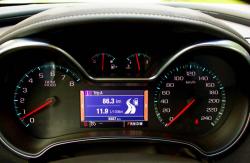 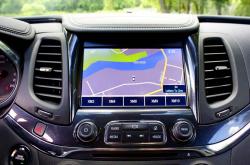 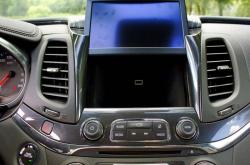 2014 Chevrolet Impala. Click image to enlarge |
The Impala’s MyLink features a much larger and brighter screen with touch features that proved to be more useful to all four drivers. Chevrolet also enables full operation of the navigation system even when the car is in motion if it senses someone seated in the passenger seat. To top it off, the whole screen slides up at the touch of a button revealing a great hidden cubby beneath for a wallet or sunglasses.
Likewise, the larger screen coupled with back-up sensors is much appreciated when parking the Chevy. Due to the extremely high parcel shelf behind the Impala’s back seat, rearward visibility is shockingly limited, making the back-up cam and sensors a mandatory choice even on the lowest trim level.
Each car offers several active safety features. David found the Chevy’s lane departure warning a particularly effective feature. Toyota’s radar-guided adaptive cruise control, on the other hand, is overly cautious with its distance management, and slow to accelerate when it’s safe to do so.
We tasked our experts to tune the radio to their favourite satellite radio station (no problem there) and input an address into the Navigation system. Neither system could be effectively operated without help from the younger contingent or an owner’s manual. It’s safe to say buyers of these cars who do not set up their own home theatre or WiFi systems should expect to spend some time with the owners’ manual to gain useful comprehension with either car’s multimedia interface.
With its superior legibility and larger touchscreen, the Impala wins this round.
Performance
A large sedan like either of these is expected to be a sedate and comfortable highway cruiser, the likes of which could transport a happy retired couple from their adult lifestyle community in the snowbelt to a second home with a palm tree in the yard. It would consume the miles effortlessly, leaving its occupants to serenely enjoy the scenery on their seasonal pilgrimage.
Both of these cars will handily succeed in that challenge, but there are differences to their motoring personalities.
The Impala’s 3.6L V6 boasts a power advantage over the Avalon’s 3.5L V6 (305 versus 268). The Chevy’s engine has an aggressive but sophisticated snarl to it that emphasizes its greater thrust. Its six-speed automatic shifts cleanly and feels well suited to the car.
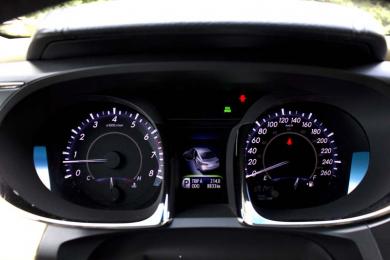 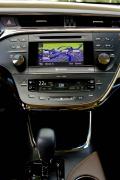 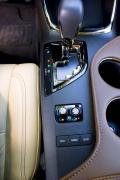 2013 Toyota Avalon. Click image to enlarge |
Despite being down on power, the Toyota’s engine will rev freely when asked to do so, and if left to cruise along at highways speeds, its own six-speed automatic keeps the V6 very quietly humming along. Even under load, the Toyota’s engine goes about its business deliberately but softly. And to help maximize the engine’s capabilities, the shifter can be moved into a fore-aft slot in its gate enabling a more engaging driving experience. The Chevy provides a silly toggle switch atop its automatic shift knob that seems like a last-minute obligatory afterthought.
While the Impala conducts itself reasonably well in the turning and braking department for such a large and heavy car, the Avalon once again comes across as the lighter and more nimble player. Although nobody will ever mistake either of these cars for sport sedans, if a driver needs to hustle to Friday Night Bingo, the Toyota is the more lively and agile choice. As Jacob pointed out, “The Avalon has managed to better the driving experience. It actually handles better, too, with less body roll and more bump absorption.”
It’s the dramatically better observed average fuel consumption rate for the Toyota at 8.5 L/100 km versus 10.5 for the Chevrolet, that clinches the performance category for the Avalon.
Value
It is rare to get press cars so ideally matched as these two. Not only are they physically fairly equal, but pricing is little more than a grand apart, with the slightly better equipped Impala costing a hair more.
With the amount of refinement, technology and comfort available in each of these machines, they both appear to be great value compared to the luxury brands that can cost many thousands more and often time offer less kit.
Based on the finishes of the cabin and the quiet refinement of the powertrain, Edward opined that the Avalon is worth the money but that “the Impala does not feel like a $45,000 car” and he would expect to spend $10,000 less for the car than the Toyota.
In terms of value, with these two it’s a draw dependent on the buyer’s priorities: features and amenities or perceived quality.
|
2014 Chevrolet Impala Overall 4 Comfort      Performance      Fuel Economy      Interior      Exterior Styling      |
|
2013 Toyota Avalon Overall 4.5 Comfort      Performance      Fuel Economy      Interior      Exterior Styling      |
Expert Choices and Conclusions
Of all our recent Comparison Tests, I cannot recall one as close as this. At the end of the day, David chose the Impala while Edward was firmly in the Avalon camp. And while you might assume each of our experts was blinded by personal brand allegiance, you should know that the Chevy was selected by someone with two import brands in the garage, while the Toyota was picked by the GM owner.
More curious though is that each of our experts have recently purchased their vehicles and yet despite being the prime demographics for our test cars, each chose a crossover SUV rather than a large sedan. Neither gentleman had considered a large sedan for their current active retirement lifestyle needs, which begs the question, just who does need one? Is this a dying breed?
For Jacob, he concluded, “the Impala is rougher, less polished, and has too many little ticks that would annoy long-term owners” making the Avalon his choice.
With its excellent engine, impressive styling and features, the Impala is an emotional choice. But ultimately the overall refinement, efficiency and luxuriant interior help Toyota’s stellar new Avalon eke out three-to-one vote victory.
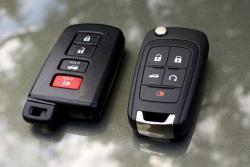 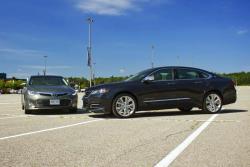 2014 Chevrolet Impala vs 2013 Toyota Avalon. Click image to enlarge |
Pricing: 2014 Chevrolet Impala LTZ
Base Price: $39,645
Options: Comfort/Convenience Package – $1,365 (ventilated front seats, heated steering wheel, memory driver’s seat, power tilt and telescope wheel, universal home remote); MyLink with touchscreen – $995; Premium Sound Package – $880; 20-inch aluminum wheels – $420.
Destination: $1,550
A/C Tax: $100
Price as tested: $44,955
Pricing: 2013 Toyota Avalon Limited
Base Price: $38,900
Options: Premium Package – $2,950 (Rear seat climate controls, premium stereo, pre-collision system, heated rear seats, dynamic radar cruise control, power rear window sunshade, automatic high beam feature).
Destination: $1,565
A/C Tax: $100
Price as tested: $43,515
Competitors:
Buick Lacrosse
Chrysler 300
Ford Taurus
Nissan Maxima
Lexus ES 350
Kia Cadenza
Crash Test Results:
National Highway Traffic Safety Administration (NHTSA)
Insurance Institute for Highway Safety (IIHS)











